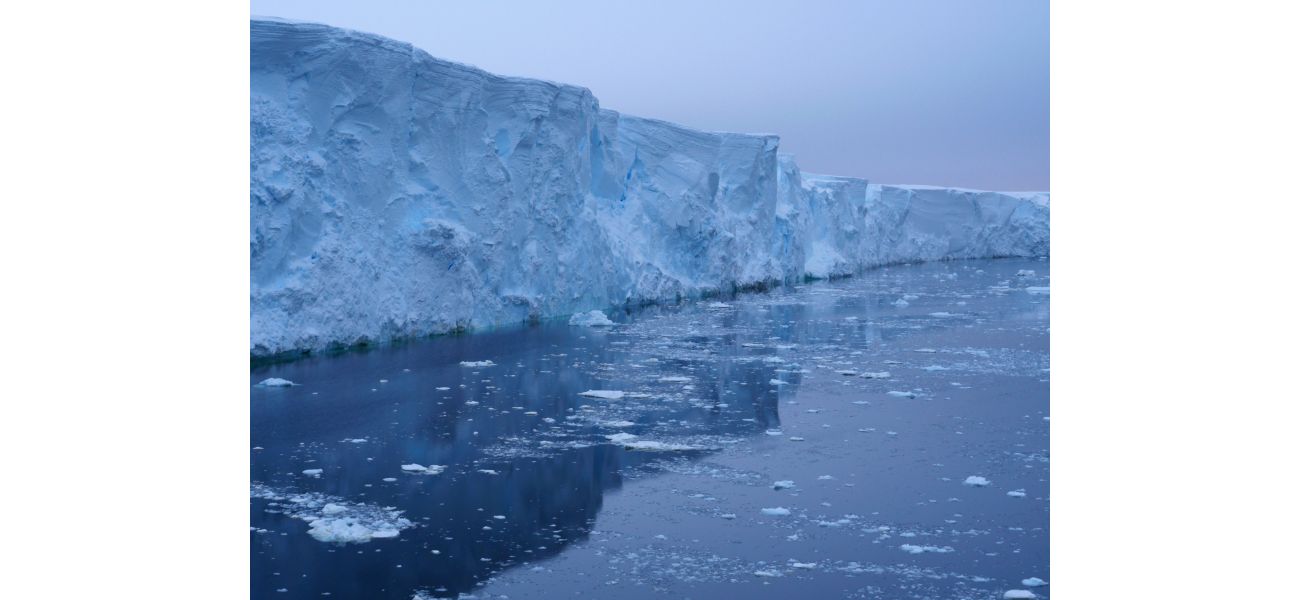Antarctica's potentially catastrophic glacier on the brink of collapse, according to experts.
Thwaites Glacier is at high risk due to its location.
September 21st 2024.

Scientists have issued a warning about a glacier in Antarctica that has been dubbed the "Doomsday Glacier" due to its potential to cause a catastrophic rise in sea levels. This glacier, known as Thwaites Glacier, is the same size as Great Britain or Florida and has been closely monitored by researchers from the British Antarctic Survey.
Using advanced technology, such as underwater robots, the team was able to gather new data on Thwaites Glacier. The results were concerning, as they indicate that the glacier, along with much of the West Antarctic Ice Sheet, could disappear by the 23rd century. This could result in a two-foot rise in sea levels, submerging large areas of land.
Thwaites Glacier is an impressive 74.5 miles wide, making it the widest glacier on Earth. Previous studies have also shown that the amount of ice flowing into the sea from Thwaites and its neighboring glaciers has more than doubled in the past few decades. This is a significant contributor to the current global sea level rise of 4.6mm/year, with the Amundsen Sea Embayment, where the glacier is located, accounting for eight percent of this rise.
What makes Thwaites Glacier particularly vulnerable is its size and location. It is up to 13,100 feet thick and rests on a bed that slopes downwards towards the heart of West Antarctica. This means that its interior lies more than 1.2 miles below sea level, while the bottom of the glacier at the coast is quite shallow. As a result, the glacier is retreating due to the warming of the ocean and is considered unstable.
If Thwaites Glacier were to collapse entirely, it could cause sea levels to rise by three to six feet, with the potential for even more from the entire West Antarctic Ice Sheet. This would have devastating consequences for coastal communities all over the world, from Bangladesh to low-lying Pacific islands, and from New York to London.
In their latest study, the team aimed to develop a more accurate prediction of when and how Thwaites Glacier will change in the future. Dr. Rob Larter, a marine geophysicist from the British Antarctic Survey, explains, "There is a consensus that Thwaites Glacier retreat will accelerate sometime within the next century. However, there is also concern that other factors, which are not yet well understood, could cause it to retreat even sooner."
The team's findings suggest that Thwaites Glacier is on track to collapse by the 23rd century at the latest. This is a worrying prediction, as the latest computer models show that the ice loss will continue to accelerate through the 22nd century, potentially leading to the collapse of the entire West Antarctic Ice Sheet. This would result in a staggering 10.8-foot rise in global sea levels.
Given the severity of these predictions, the researchers are calling for immediate action to reduce greenhouse gas emissions. Dr. Ted Scambos, US science coordinator of the International Thwaites Glacier Collaboration, emphasizes the importance of taking action now, stating, "Immediate and sustained climate intervention will have a positive effect, but it will be delayed, particularly in moderating the delivery of warm deep ocean water that is the main driver of retreat."
In conclusion, the collapse of Thwaites Glacier would have devastating consequences for our planet, especially for coastal communities. It is crucial that we take urgent action to reduce our greenhouse gas emissions to prevent this catastrophic event from occurring.
Using advanced technology, such as underwater robots, the team was able to gather new data on Thwaites Glacier. The results were concerning, as they indicate that the glacier, along with much of the West Antarctic Ice Sheet, could disappear by the 23rd century. This could result in a two-foot rise in sea levels, submerging large areas of land.
Thwaites Glacier is an impressive 74.5 miles wide, making it the widest glacier on Earth. Previous studies have also shown that the amount of ice flowing into the sea from Thwaites and its neighboring glaciers has more than doubled in the past few decades. This is a significant contributor to the current global sea level rise of 4.6mm/year, with the Amundsen Sea Embayment, where the glacier is located, accounting for eight percent of this rise.
What makes Thwaites Glacier particularly vulnerable is its size and location. It is up to 13,100 feet thick and rests on a bed that slopes downwards towards the heart of West Antarctica. This means that its interior lies more than 1.2 miles below sea level, while the bottom of the glacier at the coast is quite shallow. As a result, the glacier is retreating due to the warming of the ocean and is considered unstable.
If Thwaites Glacier were to collapse entirely, it could cause sea levels to rise by three to six feet, with the potential for even more from the entire West Antarctic Ice Sheet. This would have devastating consequences for coastal communities all over the world, from Bangladesh to low-lying Pacific islands, and from New York to London.
In their latest study, the team aimed to develop a more accurate prediction of when and how Thwaites Glacier will change in the future. Dr. Rob Larter, a marine geophysicist from the British Antarctic Survey, explains, "There is a consensus that Thwaites Glacier retreat will accelerate sometime within the next century. However, there is also concern that other factors, which are not yet well understood, could cause it to retreat even sooner."
The team's findings suggest that Thwaites Glacier is on track to collapse by the 23rd century at the latest. This is a worrying prediction, as the latest computer models show that the ice loss will continue to accelerate through the 22nd century, potentially leading to the collapse of the entire West Antarctic Ice Sheet. This would result in a staggering 10.8-foot rise in global sea levels.
Given the severity of these predictions, the researchers are calling for immediate action to reduce greenhouse gas emissions. Dr. Ted Scambos, US science coordinator of the International Thwaites Glacier Collaboration, emphasizes the importance of taking action now, stating, "Immediate and sustained climate intervention will have a positive effect, but it will be delayed, particularly in moderating the delivery of warm deep ocean water that is the main driver of retreat."
In conclusion, the collapse of Thwaites Glacier would have devastating consequences for our planet, especially for coastal communities. It is crucial that we take urgent action to reduce our greenhouse gas emissions to prevent this catastrophic event from occurring.
[This article has been trending online recently and has been generated with AI. Your feed is customized.]
[Generative AI is experimental.]
0
0
Submit Comment





